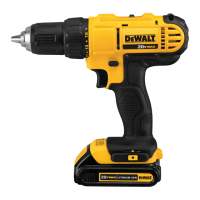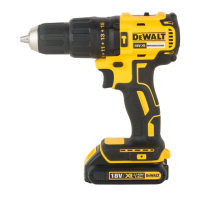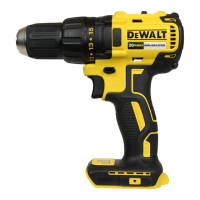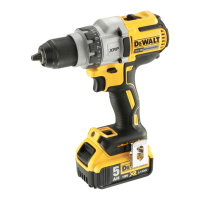12
ENGLISH
WARNING: To reduce the risk of serious personal
injury, ensure the screw holding the belt hook issecure.
IMPORTANT: When attaching or replacing abelt hook, use only
the screw that is provided. Be sure to securely tighten thescrew.
Abelt hook
11
can be be attached to either side of the tool
using only the screw
12
provided, to accommodate left- or
right-handed users. If the belt hook is not desired at all, it can be
removed from thetool.
To move the belt hook, remove the screw
12
that holds it in
place then reassemble on the opposite side. Be sure to securely
tighten thescrew.
Installing aBit or Accessory into
aKeylessChuck (Fig.D)
WARNING: Do not attempt to tighten drill bits (or
any other accessory) by gripping the front part of the
chuck and turning the tool on. Damage to the chuck
and personal injury may result. Always lock off trigger
switch and disconnect tool from power source when
changingacces sories.
WARNING: Always ensure the bit is secure before starting
the tool. Aloose bit may eject from tool causing possible
personalinjury.
Your tool features akeyless chuck
10
with one rotating sleeve
9
for one-handed operation of the chuck. To insert adrill bit or
other accessory, follow thesesteps.
1. Turn tool off and remove batterypack.
2. Grasp the black sleeve of the chuck with one hand
and use the other hand to secure the tool. Rotate the
sleeve counterclockwise far enough to accept the
desiredaccessory.
3. Insert the accessory about 19 mm into the chuck and
tighten securely by rotating the chuck sleeve clockwise with
one hand while holding the tool with the other. Your tool is
equipped with an automatic spindle lock mechanism. This
allows you to open and close the chuck with onehand.
Be sure to tighten chuck with one hand on the chuck sleeve and
one hand holding the tool for maximumtightness.
To release the accessory, repeat steps 1 and 2above.
Speed Selection (Fig.A)
The tool features two speed settings for greaterversatility.
NOTE: Do not change speeds when the tool is running.
Always allow the tool to come to acomplete stop before
changingspeed.
1. To select speed 1 (high torque setting), turn the tool off and
permit it to stop. Slide the speed selector
7
back (away
from thechuck).
2. To select speed 2 (high speed setting), turn the tool off and
permit it to stop. Slide the speed selector
7
forward (toward
thechuck).
If the tool does not change speeds, confirm that the speed
selection switch is completely engaged in the forward or
backposition.
Mode Selection (Fig. A)
The mode selection collar
6
can be used to select the correct
operating mode depending upon the plannedapplication.
To select, rotate the collar until the desired symbol aligns with
thearrow.
Symbol Mode
Drilling
1–15 Screwdriving (higher number = greater torque)
Variable Speed Trigger and Forward/Reverse
Control Button (Fig. A)
The drill is turned on and off by pulling and releasing the
variable speed trigger
4
. The farther the trigger is depressed,
the higher the speed of the drill. Your tool is equipped with
abrake. The chuck will stop as soon as the trigger switch is
fullyreleased.
Aforward/reverse control button
5
determines the rotational
direction of the tool and also serves as alock-offbutton.
• To select forward rotation, release the trigger and depress
the forward/reverse control button on the right side of
thetool.
• To select reverse, depress the forward/reverse control button
on the left side of thetool.
NOTE: The centre position of the control button locks the tool
in the off position. When changing the position of the control
button, be sure the trigger isreleased.
NOTE: Continuous use in variable speed range is not
recommended. It may damage the switch and should
beavoided.
NOTE: The first time the tool is run after changing the direction
of rotation, you may hear aclick on start up. This is normal and
does not indicate aproblem.
OPERATION
Instructions for Use
WARNING: Always observe the safety instructions and
applicableregulations.
WARNING: To reduce the risk of serious personal
injury, turn tool off and disconnect battery pack
before making any adjustments or removing/
installing attachments or accessories. An accidental
start-up can causeinjury.
Proper Hand Position (Fig. E)
WARNING: To reduce the risk of serious personal injury,
ALWAYS use proper hand position asshown.
WARNING: To reduce the risk of serious personal
injury, ALWAYS hold securely in anticipation of
asuddenreaction.
Proper hand position requires one hand on the main handle
3
and one hand on the batterypack.

